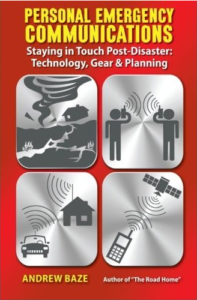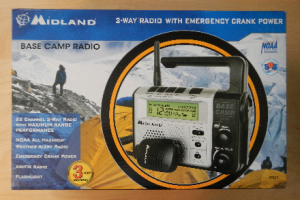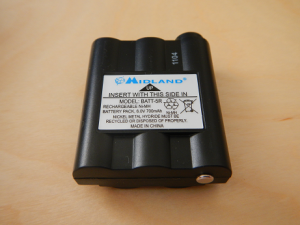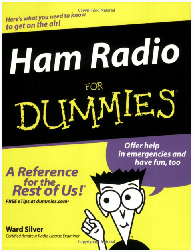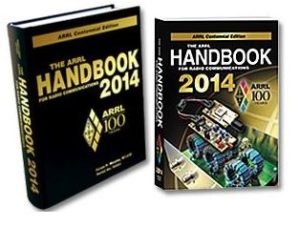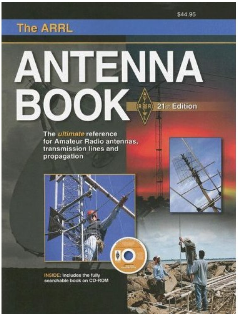Sorry everyone – it appears that TriSquare has stopped producing eXRS radios! I’ll leave this article up in case you come across a couple at a flea market. But you have another option! –> What FHSS technology is available now? Motorola makes the DTR650 – see more details here.
Thanks,
Andrew
——————————————
Frequency-hopping, spread-spectrum communications – available to everyone with no license!
Do you have anything private to discuss on the radio? Are you concerned about people listening in? Are you tired of hearing neighbors, vacationers, and random kids constantly blabbering on all the channels of your FRS/GMRS (common handheld) radio when you have important business to get done?
Did you know that high-tech, frequency-hopping handheld radio communications are available without a license? Did you know that FRS/GMRS radios usually have only 22 channels, and that a new system has 10,000,000,000 “channels” available? To learn what this amazing, little-known (until now!) technology is, keep reading. I’ll start with a few questions, and then dive into the specifics.
THE PROBLEM
Do you have a plan for communicating during an emergency situation? What about if your cell phone and land-line phone aren’t available? I have an option for you that few people are aware of, which has some amazing, high-tech capabilities. Prepare to be amazed… in a minute.
Let’s set some context. If you’ve been reading my blog, and if you’ve read my Emergency Communications Primer (free when you sign up for my newsletter), you’ll know that you have a few options, and the most useful are FRS/GMRS and amateur radio. (There are some other options, e.g., CB and marine radio, which may be applicable for you, in your area, but they still have a limited number of channels available, just as with FRS/GMRS).
Every option has its pros and cons. The easiest and least expensive option is usually the FRS/GMRS (Family Radio Service / General Mobile Radio Service) radio, and that’s what many people have already. But for about the same price, and the same effort (relatively low price, no license needed) you have another option, and option that changes the game significantly.
Let’s quickly look at another key limitation of FRS/GMRS. Since this system has a limited number of channels and since these radios are so common, you should expect to have noisy competition for use of your radio at times (depending on your location – more people will mean more noise), and that’s the last thing you’ll want in an emergency. In addition, you may want an option that you can’t get with ANY other system, whether FRS, CB, marine, aviation, amateur radio, or even public service (police, fire) frequencies (which you can listen to on a scanner). What is it? Privacy.
None of these other options mentioned (unless law enforcement is using scrambled radios – that’s a different beast, and usually unavailable to non-spook civilians) allow you to speak in private. Anyone with a similar radio or a scanner can listen to your conversation. Do you want to have a sensitive conversation? Do you need to discuss a topic that would put you in danger if someone else could hear it? Of course, you’re not going to talk about moving your gold hoard from your house to the one down the street, but what if you needed to ask a neighbor for help because you hurt your back and couldn’t get up off the floor? And what if another “neighbor” somehow heard what was going on, knew you or somehow determined where you lived, and decided to liberate you of your emergency supplies or anything else? What if you live in an area where have to assume that some of the people listening are not good people? And if you find any of those scenarios unlikely, what if you simply prefer privacy for privacy’s sake?
If you only have FRS or amateur radio, assuming your frequency is available in the first place, you can “obfuscate” (confuse other listeners) your conversation by talking in code. Per FCC rules, this is not allowed on amateur radio frequencies (although it’s unlikely that the FCC will be enforcing such rules during the time of a disaster), and anyone can still listen in. You may even attract unwanted attention with this approach (unless your codes sound like normal conversation). This also means you and whoever you’re talking with will need to remember what the code words or phrases are, especially if you’re stressed out! Talking like you normally talk would be much easier. There must be an easier way…
THE SOLUTION
There is! It’s time! We have a solution. You can use these relatively new, effectively un-interceptable radios that use “Frequency-Hopping Spread Spectrum” technology. (Although I suspect that the FCC/The Man could intercept them, using fancy, uncommon gear. The traffic isn’t encrypted. It’s just transmitted in a different way.) These radios constantly switch from one frequency to another during the transmission, and they automatically synchronize between radios. If you were trying to listen in and monitored any single frequency during the discussion (which is what a scanner will do – one frequency at a time), you would theoretically hear a microsecond blip of noise, and nothing more. If you have a compatible radio, however, you hear the whole conversation! Nobody else can hear a thing.
 There is one brand of radio that uses this technology, available to the general public. It’s called TriSquare eXRS, and you should probably get one, if you need to be able to talk without interference, don’t want casual listeners to be able to intercept your conversation, and want some other cool options built in.
There is one brand of radio that uses this technology, available to the general public. It’s called TriSquare eXRS, and you should probably get one, if you need to be able to talk without interference, don’t want casual listeners to be able to intercept your conversation, and want some other cool options built in.
Additional Specs
These radios use the 900 MHz frequency band, which will limit your range in some ways, as with FRS/GMRS. Every set of frequencies will have different propagation characteristics (meaning that the radio waves can travel farther in certain cases, or through different materials better or worse than others). These radios put out one watt of power, which is relatively low (although twice as powerful as a 500 milliwatt FRS radio, and less powerful than a GMRS handheld radio, which is usually between one and five watts).
Let’s be clear: these are not long-range, powerful ham radios. They are short-range radios, useful for conversation in your neighborhood, between nearby buildings, cars in a convoy, etc.. Don’t expect them to work 10 or 20 miles away. In my experience they work for a couple miles in open territory, and for a couple hundred meters in downtown, steel-and-concrete city territory, depending on what’s in your way. Of course, if you don’t have buildings between radios, the range grows considerably. Nonetheless, they still have some incredible features to offer. Keep reading.
From TriSquare website, with my highlighting added:
“[The eXRS radios have the] added benefit of wide band digital security and privacy provided by the frequency hopping spread spectrum algorithm. Maintaining the information signal as narrow band FM modulation centered on discrete frequencies allows for a large pool of non-overlapping hopping frequencies to draw upon within a given section of the radio frequency (RF) spectrum. The pseudo-random drawing of the hopping frequencies spreads the total signal power equally over the entire bandwidth of the RF spectrum used, which ensures minimal interference between many simultaneous, independent users.
Interference Free is a major advantage that eXRS has over existing FRS and GMRS radios. Based on a contracted study from the Electrical and Computer Engineering Department of a major university, more than 100,000 eXRS users within talk range can enjoy uninterrupted communications. Whereas, FRS/GMRS quickly becomes unusable with just a few tens of users within range of each other. Bottom-line is that the eXRS two-way radios provide private communications in areas where FRS/GMRS conversations can be congested or impossible.”
Let’s talk features. The radios are not set up to talk on FRS/GMRS frequencies, and can only communicate with other eXRS radios. This shouldn’t be a surprise. They can receive NOAA weather radio transmissions, which is great (and don’t underestimate the value of weather radio – it’s super-handy!).
Here are some of the cool features available, that I haven’t seen on any other radios:
- You can identify any specific contact or group of contacts using unique alphanumeric codes
- You can page/call a specific radio or person using a unique (5 available) tone
- You can select a group or an individual, depending on who you want to talk with
- You can identify any radio with a 10-digit number, which gives you about 10 billion options!
- Call waiting!
- Voice-operated (“VOX”) operation
- Text messaging (sending whatever message you like, or pre-defined messages), and your radio can store messages as they come in, and you can retrieve them at your leisure
- You can clone radios or transfer contacts, no cables needed
- And now they even come in camouflage 🙂
These radios are truly awesome!
There are two models, one with just a few keys (TSX100), and one with a full keypad (TSX300). I recommend the full keypad, because it gives you more flexibility. It costs a bit more, but I think the added ability to easily enter numbers, etc., make it worth it.

TSX-300
If you aren’t inclined to get an amateur radio license (although I highly recommend it – it’s easy and extremely useful!), this can be a useful way to communicate in a densely-populated or otherwise noisy area, or if you need privacy and text messaging features. Plus, these radios are just plain cool!


